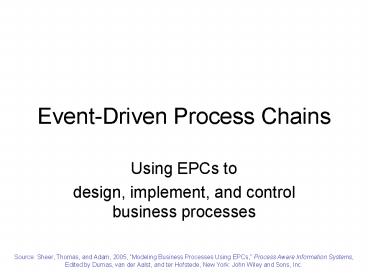EventDriven Process Chains - PowerPoint PPT Presentation
1 / 15
Title:
EventDriven Process Chains
Description:
item. send. payment. 4. Information Flows. This view can be interpreted as an ERD (Chen, 1976) ... item. completed. an event. processes order. supplier. plans ... – PowerPoint PPT presentation
Number of Views:28
Avg rating:3.0/5.0
Title: EventDriven Process Chains
1
Event-Driven Process Chains
- Using EPCs to
- design, implement, and control business processes
Source Sheer, Thomas, and Adam, 2005, Modeling
Business Processes Using EPCs, Process Aware
Information Systems, Edited by Dumas, van der
Aalst, and ter Hofstede, New York John Wiley and
Sons, Inc.
2
SAP
- The EPC notation was developed in a collaboration
between SAP AG and the University of Saarland
(Professor August-Wilhelm Scheer) - EPC is the key component of SAP R/3s modeling
concepts for business process engineering and
customization - EPC is supported by
- SAPs NetWeaver System, and by
- SAPs ARIS, an integrated toolset for designing,
implementing, and controlling business processes
3
Foundations
- EPC is based on the concepts of stochastic
networks and petri nets - After the development of the ARIS toolset, the
basic EPC was extended - We do not distinguish the EPC from the eEPC,
because the latter faithfully contains former - In talking about EPC we mean the eEPC
4
BFOI four views
- Business Flows the business units involved in
the process including their output and
communication relationships - Function Flows the behavior of the process
- Output Flows the results of the process
- Information Flows the interchange of documents
5
1. Business Flows
Example Ordering Process
- This view can be interpreted as a context
diagram (DFD-paradigm) or as an interaction
diagram (UML-paradigm)
The sequence of events is not clear Activities
can be added selectively
6
2. Function Flows
Example Ordering Process
- This view characterizes the business process
The sequence of activities is clear
Business units can be added selectively
7
3. Output Flows
Example Ordering Process
ordersupplies
process order
pay
enterorder
planmanufacturing
processorder
manufactureitem
shipitem
sendpayment
manufactureitem
shipitem
Bytes, Bucks, and Boxes
- This view does not characterizes the business
process
The sequence of activities is not clear
Business units, not included for clarity
8
4. Information Flows
Example Ordering Process
supplier data
inventory data
credit data
supply requirements
order data
payment data
order data
operations data
manufacturing data
invoice amount
- This view can be interpreted as an ERD (Chen,
1976)
The sequence of activities is nearly clear
An activity may require many information services
An information service may invoke many activities
9
Single Views of the BP
- None of the BFOI views is able to completely
capture the entire business process - We must, therefore, combine the views
- Use any one as the basis, and integrate the
others into it - Typically one uses the Function Flow as the base
view
10
Consolidated View
Example Ordering Process
This view is known as Control Flowssolid
arrows control the eventsthrough the use of
logical operators
- In this consolidated view Function Flows are
enhanced with events
Events trigger information flows, messages
Output Flows are added to complete the view
11
Events
- Events make it possible to better describe the
business process - Events describe condition changes
- Events can characterize the results of an
activity - Events trigger the next function
- Control Flows (solid arrows) are executed by
events that they trigger, after which information
regarding the beginning of the next event is
transferred to the next entity - Control Flows determine how functions react to
events - Messages can also include additional attributes
besides information regarding the beginning of
the event
12
11 Rules for Modeling EPCs
- The three core nodes of an EPC are activities,
events, and connectors - The name of an event should reflect its
characteristic as a point in time - The name of an activity should reflect the time
consuming feature of the task - Connectors are represented by a circle within
the circle, the connector is defined through the
corresponding symbol the connector can be split
into an upper and a lower part, reflecting the
differences between incoming and outgoing
connection rules
13
11 Rules for Modeling EPCs
- To clearly define the beginning and ending of a
business process, every EPC starts and ends with
one or more events - An EPC contains at lease one activity
- An EPC can be composed of several EPCs
- Edges are always directed and connect elements in
the sequence order of the business process being
modeled
14
11 Rules for Modeling EPCs
- An event cannot be the predecessor or the
successor of another event - An activity cannot be the predecessor or the
successor of another activity - Each event and each activity has only one
incoming and/or one outgoing edge
15
Guidelines for Modeling EPCs
- First, determine the exact name of the process to
be modeled. This is a simple but very important
step, as it must be clear which process is meant.
Choose a title everyone agrees on. - Determine the initial event(s) and the final
event(s) - Fill the space between the initial and final
events with the basic control flow. Use the
function view model as the basis by focusing on
verbs. - Determine one (or more) event(s) for each
transition between activities make sure each
event you pick is produced by the preceding
activity and that it is needed to trigger the
next activity. - Check with the 11 Rules for Modeling EPCs
- Last, add the business units, the output flows,
and the information flows.

